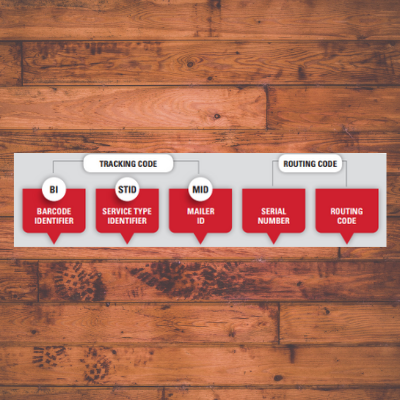I’ll admit: When I first learned about the Intelligent Mail barcode, I asked for a dumbed-down description. I mean, it’s a lot of stuff in one little barcode! And that’s the point.
What is the Intelligent Mail barcode?
The Intelligent Mail barcode (IMb) is a 65-bar Postal Service™ barcode that is used to sort and track letters and flats. It allows mailers to use a single barcode to:
- Participate in multiple Postal Service programs simultaneously
- Track individual mailpieces
- Have greater visibility to the mailpiece through its journey in the mail stream
Who uses the Intelligent Mail barcode?
The IMb was introduced nearly a decade ago, and now all mailers need to have it to receive Postal Service tracking and discounts. It applies to First-Class Mail® Letters and flats, Marketing Mail® Letters and flats, Periodical letters and flats, Bound Printed Matter flats, and Reply Mail.
Where the IMb?
On letters, the IMb is located in the address block or the barcode clear zone in the lower right of the envelope. On flats, it must be on the address side (or front side) of the mailpiece and at least 1/3-inch from any edge of the piece. The IMb is typically printed by the mailer or the presort house.
How big the IMb?
The IMb is between 2.667 and 3.225 inches wide (with some specifications on how to measure), and 0.125 to 0.165 inches high.
What information is contained in the 65 bars that make up the Intelligent Mail barcode?
The barcode contains a great deal of information and all 65 bars are required. There are up to 31 digits encoded into 65 vertical bars. It does so with a 4–state symbology – and no, 4-state doesn’t refer to four of the 50 states, the four states refer to the size and placement of the bar, called full bar, ascender, tracker, or descender. The 31 digits are be broken down into:
- 20-digit Tracking Code, which tells us the identification of the mailer plus unique mailpiece information
- 11-digit Routing Code, which consists of the Delivery Point Zip code
The Tracking Code, or first 20 of the 31 digits, can be further broken down into:
- Barcode Identifier (BI) – Required, 2 digits.
- Service Type Identifier (STID) – Required, 3 digits.
- Mailer ID (MID) – Required except in the case of Origin IMb Tracing barcodes, where the Mailer ID and Serial Number fields are combined. The MID is 6 or 9 digits.
- Serial Number – Required when Origin IMb Tracing is not used. It is 6 or 9 digits depending on the length of the MID, as the two together total 15 digits.
The 11-digit Routing Code consists of:
- The Delivery Point Zip code is 0, 5, 9 or 11 digits (depending upon the amount of routing information). Mailers may choose not to populate this field. The terms “Delivery Point ZIP code” and “Routing Code” can be used interchangeably.
Learn more about how to read an IMb here.
When are IMbs unique?
IMbs can be, but are not always required to be, unique. Uniqueness is required for Full Service Intelligent Mail or Origin IMb Tracing customers, and in those cases the MID and serial number can create a barcode unique to each mailpiece. Currently, serial number uniqueness is not required to qualify for basic automation prices.

How to Read the Intelligent Mail barcode Guide
Tension has prepared an easy-to-read overview of how to read the IMb, available to you. Click here to download.
Now that you have the who, what, when, where and how of IMbs, you can count yourself among those who are intelligent about the Intelligent barcode. More information can be found here and at https://postalpro.usps.com.
Disclaimer: All approvals must come from the USPS®. The information presented here is for illustrative purposes only.




